Why You Have a High Moz Spam Score (And Does It Matter?)

We all want our websites to perform well, and as such, we strive to find and use as many valid metrics as we can. Among the best metrics to use – at least since Google made the decision to hide PageRank from the public – are the Moz ranks for Domain Authority and Page Authority. Moz is, of course, a widely respected authority in the world of online marketing.
Moz offers other scores and ranks as well, and one of those is the Spam Score. The "Spam Score" is the Moz metric that estimates the likelyhood that a website is a low quality spam website. A 1% means it is unlikely that the site is spammy, and a 82% means that the site is almost certainly a spam site, for example.
So what does spam score actually mean? Is it dangerous to have a high spam score? Is there anything you can do about it? And does it really matter?
Let's dig in.
 30 Second Summary
30 Second Summary
You need to check your Moz spam score if you want to spot potential website issues. You'll find that a score under 30% is good, while 31-60% shows some concerns and anything above 61% needs your attention. You'll want to look at 27 different factors that can affect your score, like missing contact info, unusual domain names or spammy backlinks. If your site is new or small, you don't need to worry much about this score since Google doesn't use it directly.
What is Moz Spam Score?
Moz's spam score is a comparative metric that measures how similar a site is to other sites that are considered in some way spammy by the Google algorithm. Moz originally created the spam score in 2015, and it has evolved over the years since then. Back then, it was a number between 1 and 17, basically a checklist of spam flags. It's significantly more granular now.
Specifically, Moz maintains a large index of sites, and they monitor when sites in their index are penalized by Google. When those sites are penalized, attributes about those sites are broken down and analyzed.
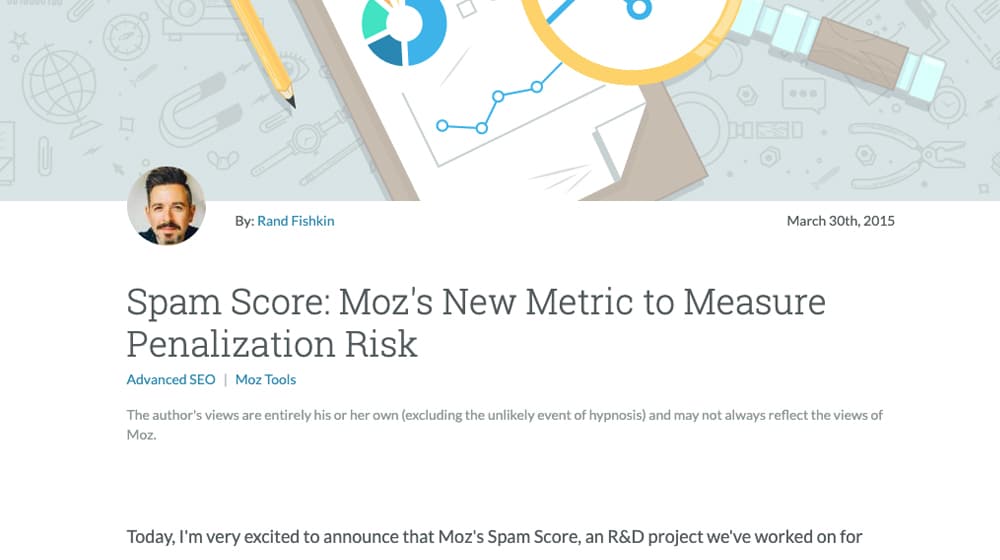
Through this process, Moz has determined 27 similarities that these sites tend to share. I'll give you a rundown of these in a moment.
When Moz analyzes your site, they look for a wide range of attributes, including those 27 spam signals. The more of these attributes your site has, the higher your spam score will be.
You can access your spam score in Moz's Link Explorer, where it will show a percentage from 1 to 100. 1-30% is a low spam score. 31-60% is a medium spam score. And, of course, 61% to 100% is a high spam score. The higher your percentage, the more likely your site is to come across as spam to various analytics tools and the ever-present Google authority.
Here's the thing about spam score: it's based on correlation, not causation. They haven't build a replica of Google's algorithm that says "when a site does X it gets penalizes" with causation. They've simply identified attributes that a site tends to have when it is penalized. Those attributes might contribute to a penalty (and some are confirmed, like exploitative links), while others might not actually have anything to do with it, but are simply shared attributes.
How to Use Spam Score
We as marketers don't like anything that implies our site is spammy, whether that's a link from another site saying our site is bad, a penalty from Google, or a publicly available metric like Moz's spam score. We naturally want to address the issue as it comes up and minimize that spam score number as much as we can.
The first thing to recognize is that a spam score even as high as 50-60% isn't a huge cause for concern. Moz's ranking isn't factored into anything but the opinions of yourself and other people who look at the score for your page. Google certainly doesn't look at it. It might be irritating to see, but a spam score of 60% only means you have some potential issues on your site to address, not that you're about to be penalized or that your site is spam.
Basically, as long as your site hasn't been penalized, your spam score isn't that important. You can use it to compare your site to your competition if you like, but the main use of spam score is to look for potential problems that might crop up.
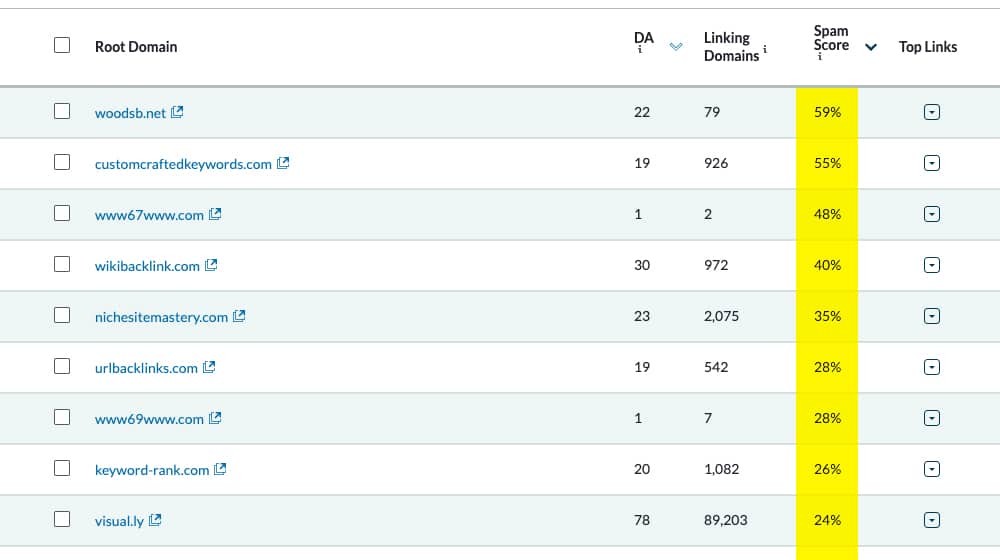
Moz does, after all, understand a lot about how SEO works. If they've flagged certain attributes of certain sites as negative, those attributes are probably negative. Changing or fixing those issues is likely to result in a boost to your search ranking, traffic, and value, even if you hadn't been suffering under a penalty in the first place. Basically, you can use it as a checklist of potential issues to review across your site.
You can also use spam score to look into any site you're thinking of writing for, getting a link from, or otherwise using as a resource for your own growth. Links are the backbone of SEO, and they're the backbone of the spam score. A domain with a high spam score linking to your site will generally increase your own spam score, even if it doesn't hurt (or even helps) your SEO.
It's worth looking into, but it's not meant to be an absolute measure of "disavow this link or suffer a penalty". In fact, Moz can't even tell if you've disavowed links, and your spam score will still take disavowed links into account.
The 27 Factors of Moz Spam Score
As I mentioned earlier, Moz came up with 27 different attributes that were shared amongst most of the sites they've found that were penalized for being spam. Some of these are simple things, while others are a little less obvious.
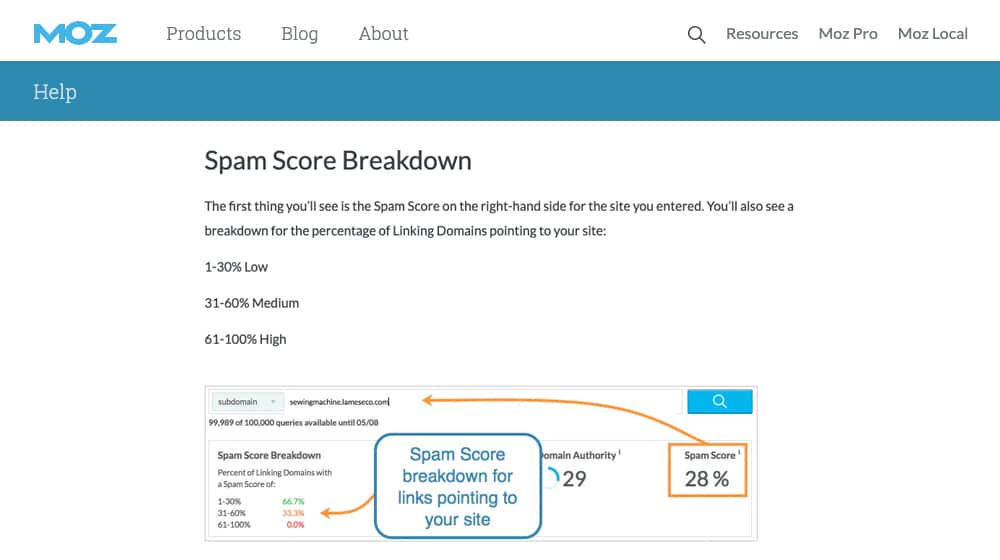
Here's the full rundown.
- The site doesn't have many pages. To fix this on your own site, just publish more content. This will gradually get better over time as your site grows.
- The site's TLD is frequently used for spam. I generally recommend using .coms only whenever possible and avoiding the spammier TLDs.
- The site's domain name is similar in length to other spam sites. Moz doesn't say what this length is, though.
- The site's domain name contains numbers. There are, of course, plenty of great sites with numbers in their domain names, so this isn't really that important.
- The site doesn't use Google Fonts API. Use it if you can.
- The site doesn't use the Google Tag Manager. Use it if you can.
- The site doesn't use DoubleClick ads. I'm not recommending that you add ads just to avoid a spam score, though.
- The site doesn't have a phone number. Legitimate businesses have business numbers, and NAP is a real SEO signal, so this one's legit.
- The site doesn't have links to LinkedIn. Spam sites are unlikely to have a business social media presence, so LinkedIn is oddly enough a decent spam signal.
- The site doesn't have a business email address. Spam sites more often than not hide any method of contacting them, so just make your contact information available.
- The site doesn't use HTTPS. Few spam sites want to pay for SSL certificates, so this makes sense.
- The site uses meta keywords. Most of us have known the keywords field is useless for years, so anyone who uses it is more than likely unaware of what they're doing, at best.
- The site doesn't get many visitors. Spam sites rarely make it big, after all. This is also why if your site is small and new, I recommend ignoring the spam score.
- The site uses rel=canonical tags to point somewhere else. Scraper sites and syndication sites do this, so it can be a spam signal. Use canonicalization properly.
- The site's page titles are very long or very short. Most non-spam sites know to keep their titles a reasonable length.
- The site's meta descriptions are very long or very short. Spam sites try to shoehorn in a lot of content and keywords there (or don't list one at all).
- The site uses a lot of meta keywords. I'm not sure why "having a lot of meta keywords" is a separate signal from "having meta keywords at all" but Moz does, so there you go.
- The site doesn't have a favicon. Specify one for the added branding in tabs.
- The site doesn't use the Facebook Pixel. Like LinkedIn, spam sites rarely establish a business presence on social media.
- The site has abnormally high or low outbound links. Keep your linking organic and natural.
- The site links to an abnormally high or low number of domains. Again, you should try to link naturally. Too few domains might indicate that you're part of a PBN, and too many might look shady, though it's hard to estimate how many is too many.
- The site has too many different outbound links for the amount of content it supports. Again, Moz doesn't say how many this is, so it's hard to estimate what's abnormal.
- The site's domain name has a lot of sequential consonants. Spam domains tend to not be English words, so this makes some sense, though it's not necessarily a great signal.
- The site uses multiple hyphens in the domain name. Using one hyphen is usually fine; two or more looks worse and is more likely a spam site.
- The site's URL paths are either very long or very short. Human-readable URLs are the way to go, usually.
- The site uses "poison words". Poison words are words that are most often only used by spam sites or websites in non-standard niches like adult content.
- The site uses CPC anchor text a lot. Basically, link anchor text spam.
What to Do with a High Spam Score
If your spam score is over, say, 20%, you can start looking for some potential problems on your site and fix them. I highly doubt Google is going to crack down on you when your spam score is anything under 50%, but it's still worth looking for issues to fix since they can boost your SEO performance overall.
First of all, if your domain is under a year old, has relatively few links, and not very much content, you can probably ignore Moz's spam score metric completely. There's simply too little data for that score to be relevant. Conversely, if your site is larger and older, and if its performance is struggling, it may be time to perform an audit to see if any of those spam indicators are cause for concern.
The first thing to check is your Google Search Console reports. Look to see if you have any search penalties. Manual actions are a definite issue you want to solve. You can also use third-party tools to check if you have an algorithmic issue and try to solve those as well. If you don't have any penalties, you can also check if you have any indexing issues, broken pages, or Core Web Vitals reports. Slow or missing pages will certainly affect your rankings and traffic.

Next, perform a thorough backlink audit. Pull your links, preferably from Google directly so you know what they're indexing and what they aren't. Look for anything that's spammy. You can do this with auditing tools, manual processes, and even cross-referencing with Moz's spam score if you like.
Keep in mind that some kinds of links are just going to be ignored by Google. I have a bunch of backlinks from Russian websites and none of them matter, positively or negatively. I could disavow them if I wanted, but there's no reason to; they don't matter. A lot of people are a lot more concerned about backlinks than they really need to be, in my opinion.
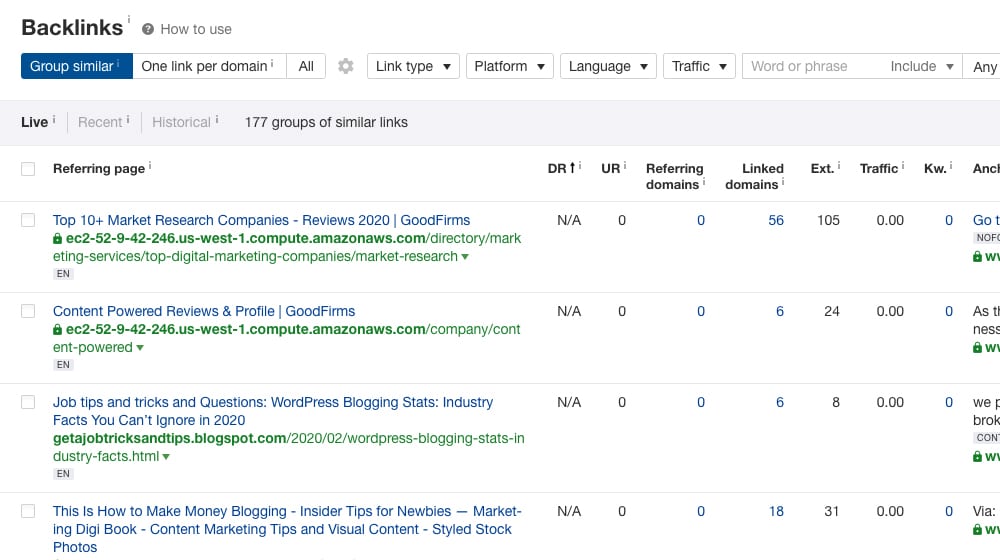
What you're actually looking for are links from malicious sites, from unrelated and obviously spam sites like payday loans, drug sellers, and so on. You're also looking for links that indicate your content was stolen by a scraper. Those are the kinds of links you want to address.
Other than that, just look at the list of factors I listed above, and see if any of them are issues you might be able to fix on your own site.
My Opinions
I'm putting this pretty far down here because I wanted to stick with the fact as much as possible - I usually cover what I've read and what is documented, but occasionally I will share what I've observed with my websites and my client's websites.
Personally, I think the Moz spam score is not something you should really worry about.
If your site has a really high spam score, you might look into reasons why, but most of the time it's just due to some bad links that Google is already ignoring, and it isn't really a cause for concern.
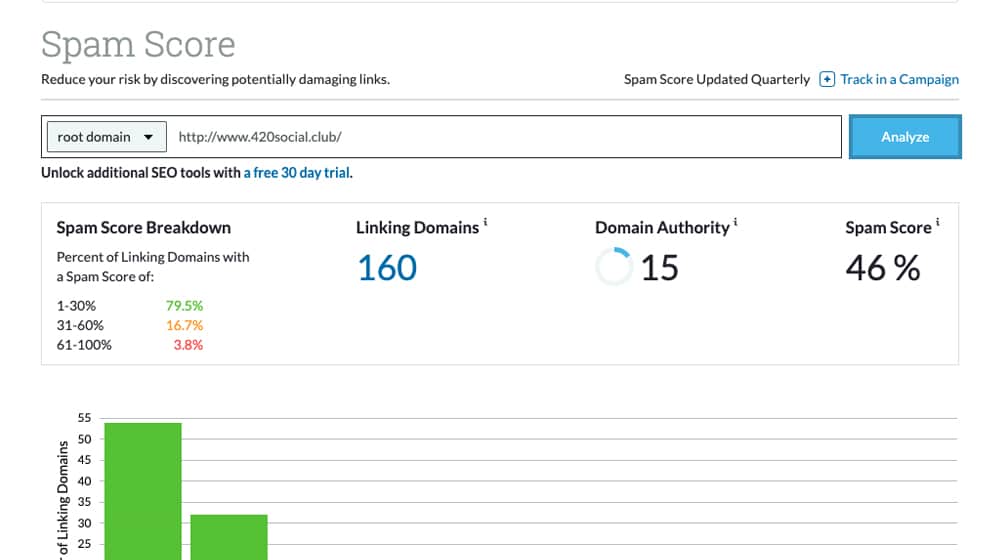
There are a lot of oddities I've seen while browsing the Moz Link Explorer. I've seen brand new sites with basically no content and zero links that have very high spam scores. I've seen major brand sites with hundreds of thousands of visitors a day have high spam scores. Moz itself has a 3% spam score, and we know Moz isn't 3% spam. There's just a lot of inconsistency with the metric overall.
I'm not just saying this because I have a high spam score and want to discredit it. You can check for yourself; my spam score is lower than Moz's, and that's even with a handful of bad automated backlinks that are outside of my control. They just have more of those than I do as they have a larger website.
The Moz spam score is only worth worrying about if you're seeing something above 25-50%, and even then it's only worth worrying about in a "maybe it's time to perform an audit" sense, not "Google deindexing imminent" sense.
Your Moz spam score is constantly updating, and their stats usually update every 30 days or so. If it's really bothering you, you can go down the list and check off each item. You don't have a favicon yet? Time to add one. Your site doesn't have many pages? Time to add a blog and start creating quality content. After making your changes, give it a month and check back to see how your score has improved.
What do you think about the Moz spam score, and do you have a high score on your site? Let us know in the comments section down below!



 30 Second Summary
30 Second Summary
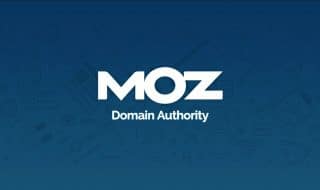


September 16, 2020
Thanks for clearing that up, I was worried my score was bad but most of these signals seems like it's just because my website is new. Appreciate it!
September 19, 2020
Hey Rehman, no problem! Happy it helped you.
November 14, 2020
sir, my new domain spam score is at 56%, I used Google disavow to remove some spammy domains domains but my spam score has not decreased, will any kind person help me to solve this problem.
November 16, 2020
Hi Bapi! Moz updates about once per month, so give it a little time to see what happens the next time it updates.
Make sure you run through the official list as well on Moz to see how many items you can check off the list,
There are 27 factors (which we mentioned in our post), so those should be easy to look at and see how many of them you can check off yourself.
Disavowing backlinks with Google won't have any effect on your Moz score since Moz is unable to see that uploaded disavow file.
October 01, 2020
I don't think it's relevant. I mean it's good to know if your site is doing great using the algorithm Moz came up with but I think its best if we focus on Google's. This is to ensure that we are following the correct algorithm and prevent being penalized by Google.
October 05, 2020
Hey William!
I somewhat miss the days of Google's public PR / PageRank system, since it was coming straight from Google, but Moz and Ahrefs provides metrics that we can't really get anywhere else. I think it's good information to have and a decent way to get an idea of a website's link authority but people do get a little obsessed over these metrics. They are designed to be comparative metrics, but people don't really use them that way.
I get asked questions all the time such as "Why did my domain authority drop", and it stems from a general mis-understanding of Moz's metrics and why/how they exist.
I agree to an extent though, it isn't super relevant unless you're doing some competition research and trying to get a feel for a competitor, or to see how you stack up against your competitors.
December 01, 2020
Dude my website spam score is increasing every month, I've never made spammy backlinks for my website, but some of these junk sites take my images and link them to my site. I'm worried, my spam score has increased to 49.
Any suggestions on what I should do?
December 02, 2020
There's nothing you can do that will make Moz ignore those links, apart from reaching out to the webmaster and trying to convince them why they should remove it.
Google is smart enough to ignore links from these sites, since they're linking out to millions of other websites as well.
Look at the list of what Moz considers when assigning a score, and if you knock out a handful of things on that list, you'll see your score improved.
A handful of spammy links wouldn't increase your score to 49 - there's some other issues that are causing that.
December 31, 2020
Hello sir, Can High Spam Score cause indexing issues?
My posts are not indexing, Its 5 days from i write an article.
January 04, 2021
Hi Sudhanshu!
Spam score doesn't affect your performance on search engines - it's a score that Moz developed to bring site issues to light.
To fix your issue, you can try going down the list and seeing how many of these things apply to you.
You should also consider submitting your sitemap to Google in their Search Console to speed up the indexing of your posts.
If weeks go by and your content still isn't indexed, there's a high likelihood your content is of lower quality. You can check for plagiarism with Copyscape, grammar issues with a tool like Grammarly, and review the sites you're linking to in your posts. Writing great content is difficult, and if Google deems it to be of lower quality, they may decide to not index that post at all.
I hope this helps you!
August 02, 2021
Thanks, James for this wonderful content.
James, my spam score has increased rapidly to 84 % please does this mean that my site will be affected and I won't appear on search engines or I should start posting my original content, and is there any hope that it will reduce someday? It's a new site, please I am scared because I have already invested so much to build this site.
I will appreciate your humble response.
August 03, 2021
Hey Abdul, thanks for hopping on chat with me!
It looks like we were disconnected, but I'm glad you left a comment here.
Put plainly; your site is brand new, so a high spam score isn't necessarily a cause for concern.
I would run through each of the factors listed in this article to see if any of them apply to you:
https://www.contentpowered.com/blog/high-moz-spam-score/#the_27_factors_of_moz_spam_score
Make sure your site is enrolled in Google Search Console, and check there for issues. This section is where your focus should be; indexing issues, mobile-friendliness, page experience, crawl issues, and so on.
August 11, 2021
Hi James
I am planning to buy a domain from the GoDaddy auction since it has an awesome backlink profile and also has hundreads of URLs indexed in SERP. It has clean Wayback history. The only issue bothering me is the MOZ spam score which is 73%. Should I worry about it or I can get around and disvow some spam links later.
August 11, 2021
Hi Roshan!
Moz spam score factors in many things other than link quality; I would go through each one and see if they apply to this site.
Some of them are not a big deal, like if the site doesn't have a favicon. If the site lacks a favicon, this contributes to the spam score, but it's also something that you can fix in 10 seconds.
If you're thinking of buying an established site, and especially if it costs a significant amount, it may be a good idea to sign up for a paid trial of Ahrefs and dig through the site in more detail. Get an estimate of its traffic, identify any glaring issues, and see if it's still something that you want to buy. It's 7 dollars for an Ahrefs trial, but it could save you a lot of headaches.
October 19, 2021
Do we really need to take action against the MOZ spam score or not? If brand new or old categories, why is it increasing continuously? What do we need to reduce the score? What is the purpose of the Google disavow tool? Why did we need to disavow the links if they won't hurt our website event their spam score is 90 to 100%? Will this spam score affect our MOZ page and domain authority? Is there any suggestion by Google on spam score issues and guidelines to reduce?
October 19, 2021
Hi Raj!
I would start by looking at those 27 factors and see if any of them apply to your site.
Spam Score (as well as DA / PA) are constantly updating, so if your spam score is increasing, they may have found new factors that raised it.
To reduce your score, go through those 27 factors and try to fix as many of them as you can.
Google Disavow Tool is an emergency tool used to alert Google of links that could be potentially harmful to website performance that you haven't been able to remove through outreach and communication with the webmaster. It should be used only by qualified SEO professionals.
The Disavow Tool will not affect any of the metrics on Moz. Moz and Google are two separate entities; these two are not related in any way.
For the most part, you can safely ignore the spam score unless your website is having performance issues. In that case, focusing on those 27 spam score issues that I listed may help you improve your site quality and fix errors to improve performance on Google.
December 05, 2021
Hello
First of all thank you very much for providing such an informative article about Moz spam scoring.
I don't know you will allow my comment if I mention my domain name, but its [redacted].
I have read and checked all of things that you have mentioned in your article one by one. But I didn't find any mistake in my site. No problem in Google search console or Analytics.
According to Moz My site have 20% of spam score. According its not something that i need to be worried about. But unfortunately People who are looking for Guest posts care about spam score and just deny my domain because of its 20% of spam score.
I have also searched some similar sites like mine in Moz just to compare Spam URLs/Links But there is nothing different. The site I have checked having spamy links higher than my domain. So as for now i Just candled the Google Disavow tool and waiting for a better solution.
I am looking forward and will highly appreciate if you contact me back or reply in the comment section.
I also have visited all the links you mentioned in your article to take complete guidelines or to find a way to stop this nonsense action taken by Moz.
Thanks and kind regards
Abdul Majid Qureshi
December 06, 2021
Hey Abdul!
I took a look at your site - it looks fine to me. Good traffic, indexing, rankings; nothing seems out of the ordinary.
It's been growing and doesn't appear to have any penalties or struggles on search engines.
I think you may be putting too much importance on Moz's Spam Score. Many things can ding you for factors outside of your control, and this has little to no coorelation to Google performance. I've seen plenty of sites with a high spam score and a perfectly healthy site with massive amounts of traffic.
My advice is to put this out of your mind for now - you're doing great, keep it up and focus on better things!
January 27, 2022
I'm completely new to this so the high spam score was worrying me. Thank god I came across this article! I think it's safe to say that I should not worry too much about it since our domain is just several months old. But I'll keep the factors you've listed in mind for future reference! Thanks!
January 28, 2022
Thanks Chris! Glad it helped 🙂
September 06, 2022
I bought an expired domain that had good backlinks and DA also. But after purchasing I found it has a spam score of 6% which bothers me a little. Because I opened the website for everyone to write and some of my users complained about spam scores.
I found you have written "Basically, as long as your site hasn't been penalized, your spam score isn't that important. " I also believe this and I didn't find any errors in the Google search console and my AdSense also approved the site. Is there any advice, please?
September 09, 2022
Hey Mr. Rahman!
I'm surprised you've had users complain about this. I wouldn't pay it any mind if I were in your shoes.
The Moz database is much smaller and updates at a slower pace than other sites, so it's likely that they haven't crawled your link index entirely and are still quite a bit behind. This incomplete database is typically why DA metrics update much slower and are generally off compared to other industry metrics.
Also, the spam score predicts how likely your website is that it is a spam site. A 6% chance is low, and you probably have a few false positives. If it were 40%, that could signify that your website needs some work.
If it bothers you, look at all the things I listed in my article and try to address each one. Otherwise, it's best to ignore this and keep growing your website! 🙂
February 18, 2023
MOZ chrome extension shows 49% spam score of my new domain, but when I check my domain at their website, MOZ knows nothing about it. Where MOZ Bar is taking data from. Is this with MOZ Bar and all metrics real?
February 21, 2023
Hi Ivo!
Moz claims their link index for Link Exporer (Mozbar) and their website (Open Link Explorer) are different, which can cause data discrepancies like this.
The Mozbar / Link Explorer data is supposed to be more accurate.
Make sure your URL prefix (https / www) are identical on both searches. That could also return two very different sets of numbers.
April 11, 2023
Thanks James!
Once I placed html site map linked from the domain, MOZ crawler was able to find all my pages. 40 days later my SPAM score went down from 49 to 7%. I also had to fix some multiple forwarding issues such as http/https and non www to www, but rot cause was MOZ was unable to crawl without html site map. I have tried first with xml sitemap which google uses, but xml was not working for MOZ
April 13, 2023
Hey Ivo!
That is an interesting strategy; thank you for sharing!
Moz also can't crawl JavaScript, unlike Google. At a certain point, we're doing these things for a shiny number on Moz that doesn't really mean much. But if you have a client or someone that is unhappy with it, it's nice to understand the various factors responsible and to have tricks like this in your tool belt.
I'll give it a try sometime; if it's successful, I'll add this to the article and credit you 🙂